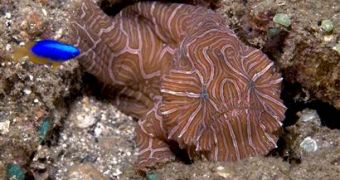It is one of the weirdest fish of the ocean: it has a human-like face, it sees binocularly (just like us) and it rather crawls into crevices than swims. This creature appears to make a new unknown family of fishes. The fish has been spotted off Ambon Island (Indonesia) and has tan- and peach-colored zebra-striping. The new species has leg-like pectoral fins (relating it to the anglerfish) which help it move into cracks and crevices of coral reefs while foraging. DNA analysis will establish its kin position. Still, the fish appears to be really unique.
"I've never seen anything like it. As soon as I saw the photo I knew it had to be an anglerfish because of the leglike pectoral fins on its sides. Only anglerfishes have crooked, leglike structures that they use to walk or crawl along the seafloor or other surfaces. The forward-looking eyes were notable," said Ted Pietsch, professor at the University of Washington, one of the world's leading authorities on anglerfishes.
Most fishes are side-eyed (having monocular vision). Their eyes have separated visual fields. Very few fish species have eyes looking in the same direction (binocular vision), like in humans. In this case, the fish has an odd flattened face and the visual fields of the eyes overlap, enabling the fish to assess distance with precision.
The fish was spotted by a dive group made of Buck and Fitrie Randolph and Toby Fadirsyair on Jan. 28 in Ambon Harbor. A second adult and two smaller juveniles were observed off Ambon on March 26. One of the adults even laid a mass of eggs. The discoverers of the fish could not find the photographed fish in any reference book.
"The fish probably escaped notice until now because they were adept at sliding into narrow crevices to hide. In the last 50 years scientists have described only five new families of fishes and none of them were even remotely related to anglerfishes," said Pietsch.
Anglerfishes are characterized by their lures growing on their foreheads from the first radius of their dorsal fin. Some species have really weird biology. The newly found species has no lures so they seek their prey.
"Several times I saw these fish work themselves through an opening that seemed much smaller than the fish, sometimes taking a minute or more to get all the way through. They must have pretty tough skin to keep from being scraped and cut, but there is no evidence of superficial injury or scars in my photographs," said David Hall, an underwater natural history photographer who took additional photos of the new fish.
"Scientists have already described 18 different families of anglerfishes and this is probably a 19th. The fish were seen in 15 ft (5 m) of water. It's possible the fish could be found at other locations," added Pietsch.

 14 DAY TRIAL //
14 DAY TRIAL //